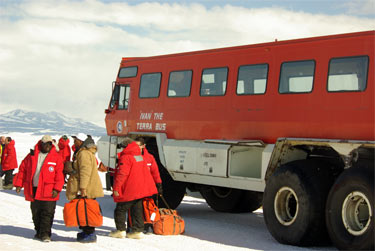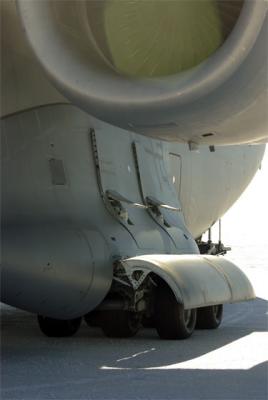I've traveled through lots of airports in my life - but NZIR, or the McMurdo Station Icerunway is now definitely one of my favorites. Orlando may have it's monorails and Dulles has those cool transports with the killer whale dorsal fins - but check out the transport system in Antarctica.
 Ivan the Terra Bus
Ivan the Terra Bus
This beast is called Ivan the Terra Bus -and the pity the driver that ever has to change a flat tire on this monster.
 Terra Bus tires
Terra Bus tires
Here are the vitals on this NZIR airport
Latitude: 77°51'14"S (-77.853950)
Longitude: 166°28'08"E (166.468761)
Elevation: 1 ft (0 m)
If you look at a map of Ross Island - you will see that this icerunway is located way out on the ice right up next to the Ross Ice Shelf - in fact it took us about half an hour of driving straight across the ice to get there. Probably the only airport in the world that can claim to be this close to sea level (and I didn't know that 1 ft was equal to 0 meters - interesting conversion factor from the website!)
 Ross Island map
Ross Island map
And here is the road, explains why we need Ivan the Terra (and how would you like the job of placing all those flags, they line the entire route!
 iceroad to airport
iceroad to airport
On your way off of Ross Island, you drive right by Scott Base - New Zealand's primary research station in Antarctica, very identifiable because every building is this beautiful shade of kiwi green.
 Scott Station
Scott Station
You can also identify it as a New Zealand Station owing to the color coded rugby pitch maintained all summer out on the ice for their crews recreational pleasure.
 rugby pitch
rugby pitch
After about fifteen minutes of driving you come to the first of two airfields maintained in the summer out on the ice. This runway is primarily for the ski equipped C130's of the New York Air National Guard 109th Airlift Wing from Scotia, NY that fly passengers and supplies between New Zealand, McMurdo, and South Pole Station
 NYANG runway and planes
NYANG runway and planes
This is an amazing operation - a complete airport setup right out in the middle of the ice in Antarctica. This 10,000 foot runway even has IFR landing capability with radar, approach lights, vasi glide slope indicators. Even more remarkable is that this runway moves twice per year - back and forth to a position right in front of McMurdo Station for the winter when the ice is stable there.
 IFR setup
IFR setup
However, we kept on driving (this airport doesn't use the usual gate system - just carve another runway out of the ice) - on about another fifteen minutes to the second runway which is home to the C17 cargo jets of the US Air Force 62nd Airlift Wing from McChord Air Force Base in Washington.** **There our ride home awaited us.
 c17 on the runway
c17 on the runway
The C17 is an incredible cargo jet - capable of carrying over 170,000 pound of cargo and even a full capacity flying 2,800 miles without refueling.
 c17 closer
c17 closer
It's 4 engines are completely reversible - at an Anchorage airshow I saw them land and stop in about 1500 feet, back up in reverse to the landing point, and take off again in less than 3000 feet - unbelievable. It is designed to handle gravel, dirt or even snow runways and lands here without even needing skiis despite it's huge bulk.
 c17 landing gear
c17 landing gear
The extra large control surfaces allow it to fly and maneuver at extremely low speeds to facilitate those short field operations and also precision airdrops. It's cargo bay is large enough to airdrop up to 102 paratroopers and equipment in a single drop, or hold even the M-1 battle tank without disassembly.
 c17 tail
c17 tail
I had been excited just to see one a few years ago and now I was getting to fly on it from Antarctica to New Zealand! US Antarctic program regulations require that you wear the majority of your extreme weather gear - just in case the plane is forced to make an emergency landing you have enough gear to survive in the cold. It did seem pretty strange to be loading up in sorrels, full wind bib pants, a fur trimmed parka, hats, gloves and sunglasses - but this wasn't a flight I was willing to risk missing.
 c17 seats
c17 seats
Next to me are my jumpseat buddies Sandra Williams, a teacher from Chile and Emily Miller, a researcher from Woods Hole Oceanographic Institute. Wish I could say that there was great fanfare and fireworks upon our departure - highlighting the success of our fantastic voyage - but it was really just another basic day in the life of McMurdo Station - they do this every day. This is just my favorite picture of the C-17 releasing flares from a plane website (http://www.answers.com/search?q=c-17-globemaster-iii)
 c17 with flares
c17 with flares
I think I was asleep before the plane left the ground - I'd spent the entire previous night up talking with the First Mate on the bridge learning about icebreaking in the Bay of Bothnia in Finland - I'd even had my chance at driving the boat a bit. It was pretty fun since anytime I drive my Dad's boat I always hit the dock so finally my skills were useful as I was supposed to run into things. It took about five and half hours to cover the 2500 miles to Christchurch, New Zealand - we arrived around 11 PM and saw our first darkness in the last ten days.
 Christchurch at night
Christchurch at night
This is the main town square where my hotel was located. But my priority now - as it was then - is to get a good night's sleep. So I'll leave this post with us off the ice - and save my stories from Christchurch for another journal. Goodbye Antarctica and good night.

